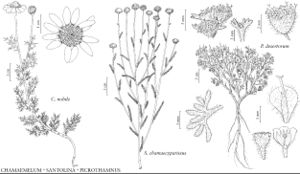Santolina
Sp. Pl. 2: 842. 1753.
Gen. Pl. ed. 5, 365. 1754.
| Taxon | Illustrator ⠉ | |
|---|---|---|
 | Chamaemelum nobile Santolina chamaecyparissus Picrothamnus desertorum | Yevonn Wilson-Ramsey Yevonn Wilson-Ramsey John Myers |
Subshrubs, [5–] 10–60 cm (sometimes ± rhizomatous; aromatic). Stems usually 1, ± erect [decumbent to ascending], branched mostly from bases [± throughout], often tomentose to lanate, sometimes glabrate or glabrous [sericeous] (hairs mostly medifixed) and gland-dotted. Leaves cauline [mostly basal]; alternate; petiolate or sessile; blades narrowly oblong or spatulate to linear, usually 1-pinnately lobed (lobes usually crowded and overall effect ± vermiform), ultimate margins entire or ± crenate, faces usually arachnose or tomentose to lanate, sometimes glabrate or glabrous [sericeous]. Heads discoid, borne singly (pedunculate). Involucres campanulate to hemispheric or broader, [3–] 6–10 [–12+] mm diam. Phyllaries persistent (soon indurate), 18–45+ in 3 (–5+) series, distinct, lanceolate to elliptic (usually carinate), unequal, margins and apices (usually light to dark-brown, sometimes purple) scarious (abaxial faces glabrous or ± arachnose, glabrescent). Receptacles convex to hemispheric, paleate; paleae ± lanceolate, ± navicular (each with central resin duct). Ray-florets 0. Disc-florets mostly 60–250+, bisexual, fertile; corollas pale to bright or deep yellow [whitish], tubes often compressed (± winged and/or saccate, ± clasping apices of cypselae), throats ± funnelform, lobes 5, lanceovate. Cypselae obconic to obovoid, sometimes slightly obcompressed, 3–5-angled, faces glabrous (pericarps sometimes with myxogenic cells, without resin sacs); pappi 0. x = 9.
Distribution
Introduced; s Europe, n Africa
Discussion
Species 8–12+ (1 in the flora).
Selected References
None.
Lower Taxa
"broader" is not a number.